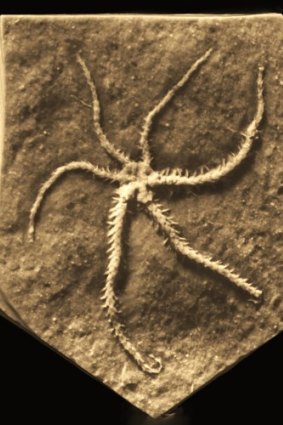
Washington: Some brittle stars give an arm and a leg to reproduce. When mates are scarce, these starfish-like sea creatures split themselves in half. Each side then regrows its missing half, creating two identical clones of the original animal.

A microCT scan revealed the details of the self-cloning britle star.Credit: Günter Schweigert /National Museum of Natural History in Luxembourg
This process, known as clonal fragmentation, is practised by almost 50 species of existing brittle stars and their starfish relatives. However, scientists have found it difficult to determine when brittle stars, a gangly group of echinoderms, started reproducing this way.
A recently discovered fossil from Germany pushes the origin of cloning sea stars back more than 150 million years. In a paper published on Wednesday in The Proceedings of the Royal Society B, a team of scientists describes the fossil of a brittle star that was petrified while regenerating three of its six limbs.
“It’s the first fossil evidence for this phenomenon,” said Ben Thuy, a palaeontologist at the National Museum of Natural History in Luxembourg and an author of the new study. The specimen, he added, shows that “clonal fragmentation is actually much older than people previously thought”.
The fossil was discovered in the Nusplingen limestone deposit in southern Germany. In the late Jurassic period, 155 million years ago, this area was a balmy lagoon home to marine crocodiles, sharks and pterosaurs. When some of these creatures died, they sank to the bottom and were buried by mud. Low oxygen levels slowed their decomposition, preventing scavengers from picking at the carcasses.
These conditions preserved fossils in incredible detail, capturing delicate structures like dragonfly wings and even a dinosaur feather. The newly described brittle star is another treasure imprinted onto the site’s limestone slabs. “You have this brittle star with every single piece in its original place, just as if it washed up on the beach a day ago,” Thuy said.
The fossil was discovered during a 2018 excavation by researchers from the State Museum of Natural History in Stuttgart, Germany. Thuy teamed up with researchers from around Germany and Austria to study it.
The brittle star’s mismatched anatomy stood out. Three of its arms were thin squiggles compared to its three other arms, which were larger and studded with spines.
The scientists placed the brittle star inside a micro-CT scanner to examine its structure. They also compared the animal’s anatomy with other brittle star species.









 Add Category
Add Category